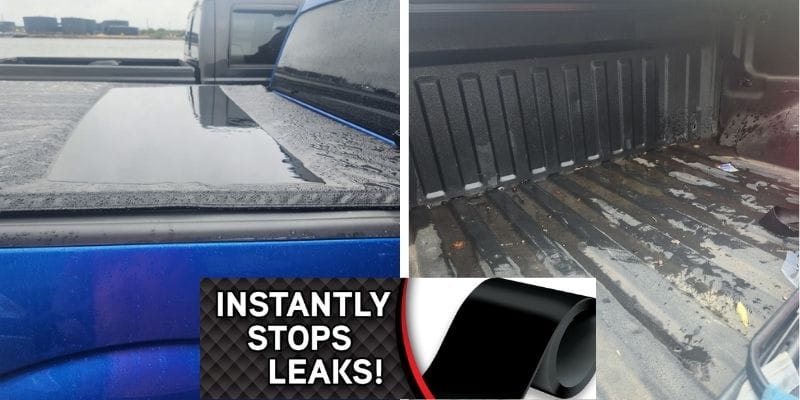You’re about to head out on a road trip, and you notice your trusty tonneau cover has sprung a leak.
Panic sets in as you imagine your cargo getting soaked. But wait, what’s that can of Flex Seal doing in your garage?
Could it be the quick fix you need? Let’s dive into the world of tonneau covers and see if this popular sealant can save the day.
Can You Use Flex Seal on Tonneau Cover?
Yes, you can use Flex Seal on soft tonneau covers to fix small leaks, tears, and worn seams. It’s a temporary solution that can extend your cover’s life, but it’s not ideal for large repairs or hard tonneau covers. Proper application is crucial for effectiveness.

Choose the Flex Seal that matches your needs, and you will find plenty of options on Amazon here.
Types of Tonneau Covers Suitable for Flex Seal and Their Repair Capabilities
Soft Vinyl Covers
Soft vinyl tonneau covers are probably the most common type you’ll see on trucks. They’re popular because they’re affordable and easy to use.
But let’s face it, they’re not invincible. Over time, you might notice:
- Small tears along the edges
- Worn-out seams that let water sneak in
- Tiny punctures from that time you accidentally tossed a sharp tool in the back
Here’s where Flex Seal can come to the rescue. It’s great for patching up those small imperfections.
You can use it to seal those pesky seams that have started to come apart or to cover up small tears before they get bigger.
Just remember, we’re talking about minor fixes here – Flex Seal isn’t magic, and it won’t bring a shredded cover back to life.
Canvas Covers
Canvas tonneau covers are tough cookies, but they’re not immune to wear and tear. They can face issues like:
- Frayed edges that start to unravel
- Small holes from constant exposure to the elements
- Weakened areas where the canvas attaches to the truck bed
Flex Seal can be a handy solution for these canvas covers too. It can help reinforce those frayed edges, preventing further unraveling.
For small holes, a careful application of Flex Seal can create a waterproof patch. And those attachment points?
A bit of Flex Seal can add an extra layer of protection, keeping water out where the canvas meets metal.
Folding Soft Covers
Folding soft covers are super convenient, but all that folding and unfolding can take its toll. Common problems include:
- Creases that wear thin and let water seep through
- Corners that start to peel or separate
- Edges that don’t quite seal as tightly as they used to
Flex Seal can be particularly useful for these types of covers. You can apply it along the creases to reinforce and waterproof them.
For those pesky corners, a careful application can help seal them back up.
And for edges that have lost their snug fit, a thin layer of Flex Seal can help create a better seal against your truck bed.
Roll-up Covers
Roll-up covers face unique challenges because of their constant movement. You might encounter:
- Worn areas where the cover repeatedly rolls and unrolls
- Small tears along the sides from friction
- Weakened seals at the tailgate end
Flex Seal can be a good temporary fix for these issues.
You can use it to reinforce those high-wear areas, potentially extending the life of your cover.
For small tears along the sides, a careful application can prevent them from getting bigger.
And at the tailgate end, where water often tries to sneak in, Flex Seal can help boost your cover’s water-resistance.
How to Use Flex Seal on Your Tonneau Cover

Step 1: Clean the Cover
First things first, you need to start with a clean slate. Here’s what you do:
- Remove the tonneau cover from your truck if possible. If not, open it fully.
- Wash the entire cover with soap and water. Pay extra attention to the area you plan to repair.
- Use a cleaner specifically designed for vinyl or canvas (depending on your cover type) to remove any stubborn dirt or grime.
- Rinse thoroughly and allow the cover to dry completely. And I mean completely – any moisture left can prevent the Flex Seal from adhering properly.
Step 2: Identify and Prepare the Problem Areas
Now that your cover is squeaky clean, it’s time to play detective:
- Carefully inspect the entire cover, paying close attention to seams, edges, and any areas that look worn.
- Mark the areas that need repair with a piece of painter’s tape nearby (not directly on the spot you’ll be sealing).
- If you’re dealing with a tear, trim any loose or frayed material with scissors to create a clean edge.
- For areas where the material has separated (like a seam coming apart), gently clean between the separated parts if possible.
Step 3: Protect Surrounding Areas
You don’t want Flex Seal where it doesn’t belong, so:
- Use painter’s tape to mask off the areas around your repair spots. Leave about a 1-inch border around each area you plan to seal.
- If you’re working on the cover while it’s still on the truck, use plastic sheeting or newspapers to protect your truck’s paint and any nearby surfaces.
Step 4: Apply the Flex Seal
Now for the main event:
- Shake the Flex Seal can vigorously for at least one minute. Trust me, your arm might get tired, but it’s worth it for an even application.
- Hold the can 8-12 inches away from the surface.
- Apply the Flex Seal in a smooth, sweeping motion. Start spraying just before the repair area and continue just past it for an even coat.
- For tears or seams, apply a thin coat on both sides of the damage, let it get tacky (about 10 minutes), then press the sides together.
- Allow this first coat to dry for about 24 hours.
Step 5: Apply Additional Coats
One coat is rarely enough for a durable repair:
- After the first coat has dried, apply a second coat using the same technique.
- For high-stress areas or larger repairs, you might want to apply a third coat after the second has dried.
- Allow each coat to dry for 24-48 hours before applying the next.
Step 6: Remove Masking and Clean Up
You’re almost done:
- Once the final coat has dried completely (give it at least 48 hours), carefully remove the painter’s tape.
- If any Flex Seal got where it shouldn’t, you can try removing it with mineral spirits – but test this on an inconspicuous area first to make sure it won’t damage your cover.
Step 7: Test and Monitor
The moment of truth:
- Reinstall your tonneau cover if you removed it.
- Spray the repaired areas with water to check for any leaks.
- Keep an eye on the repaired areas over the next few weeks. If you notice any issues, you may need to reapply or consider a more permanent solution.
Pros and Cons of Using Flex Seal on Tonneau Covers
Pros
Quick and Easy Solution
Let’s face it, when you discover a leak in your tonneau cover, you want it fixed yesterday.
Flex Seal offers a quick fix that doesn’t require any special skills.
You can usually complete the repair in an afternoon, and you don’t need to be a DIY expert to get decent results.
Affordability
Compared to replacing your entire tonneau cover or paying for professional repairs, Flex Seal is easy on the wallet.
A can of Flex Seal costs a fraction of what you’d pay for a new cover, making it an attractive option if you’re trying to squeeze a bit more life out of your current one.
Versatility
Flex Seal isn’t a one-trick pony. It can handle a variety of repair jobs on your tonneau cover, from sealing small tears to waterproofing worn seams.
This versatility means you can tackle different issues with just one product, simplifying your repair process.
Waterproof Protection
When applied correctly, Flex Seal creates a waterproof barrier that can effectively keep rain and moisture out of your truck bed.
This can be a real lifesaver when you need to protect cargo from unexpected showers.
Cons
Temporary Fix
While Flex Seal can buy you some time, it’s not a permanent solution.
Depending on the extent of the damage and how much stress the repaired area endures, you might find yourself needing to reapply or seek a more permanent fix down the road.
Aesthetic Concerns
Let’s be honest – Flex Seal isn’t going to win any beauty contests.
While it comes in different colors, it’s tough to match it perfectly to your tonneau cover.
You might end up with visible patches that affect the overall look of your truck.
Potential for Misapplication
If you’re not careful with your application, you could end up with a mess on your hands.
Overspray can be a real pain to clean up, and if you apply the Flex Seal too thickly, it might not cure properly, leading to a sticky situation (literally).
May Void Warranty
Here’s a biggie – using Flex Seal on your tonneau cover could potentially void its warranty.
Many manufacturers have specific requirements for repairs, and using an aftermarket product like Flex Seal might not meet those standards.
Limited Durability
While Flex Seal is tough stuff, it’s not indestructible.
Exposure to extreme temperatures, UV rays, and the constant movement of your tonneau cover can cause the seal to break down over time.
This means you might find yourself back at square one sooner than you’d like.
Not Suitable for Large Repairs
If your tonneau cover has significant damage, Flex Seal might not be up to the task.
It’s best suited for small tears and leaks – trying to use it for major repairs is likely to lead to disappointment and wasted effort.
Final Thoughts
Using Flex Seal on your tonneau cover can be a handy quick fix, but it’s not a miracle solution.
While it offers a budget-friendly way to extend your cover’s life, it’s important to weigh the pros and cons carefully.
For minor issues, it can be a great temporary fix. However, for significant damage or long-term protection, you might want to consider professional repairs or replacement.
Remember, your tonneau cover plays a crucial role in protecting your cargo, so choose your repair method wisely.

